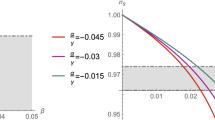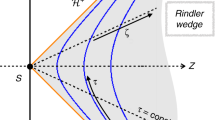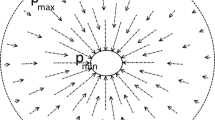Abstract
It is possible that the vacuum state we live in is not the absolute lowest one. In many spontaneously broken field theories a local minimum of the effective potential, which can be quite stable, can exist for certain parameter values. The Universe, starting at a high temperature, might have supercooled in such a local minimum. If such a metastable minimum is separated by a high enough barrier from the absolute minimum, the tunneling rate from the ‘false’ to the ‘true’ vacuum may be slow enough to not have occurred in one Hubble-spacetime-volume1,2. In that case our vaccum state might suddenly disappear if a bubble of real vacuum formed which was large enough for the bulk energy gain (equal to the product of the volume and the potential drop between false and true vacua) to exceed the surface energy density in its walls (proportional to the barrier potential). Such a bubble would expand at close to the speed of light, with enormous energy release, leaving a large attractive (ρ = −p < 0) cosmological constant in the interior, with a geometry close to anti-deSitter space1. This space-time is singularity-free if a strict vacuum, but any non-zero particle density would cause singularities to develop quickly. Although the persistence of our present vacuum for 1010 yr implies that a spontaneous transition via tunnelling is unlikely, we can ask whether a new generation of elementary particle accelerators might trigger such an unfortunate event. We show here that this chance, fortunately, is completely negligible since the region inside our past light cone has already survived some 105 cosmic ray collisions at centre of mass energies of 1011 GeV and higher.
This is a preview of subscription content, access via your institution
Access options
Subscribe to this journal
Receive 51 print issues and online access
$199.00 per year
only $3.90 per issue
Buy this article
- Purchase on Springer Link
- Instant access to full article PDF
Prices may be subject to local taxes which are calculated during checkout
Similar content being viewed by others
References
Coleman, S. & De Luccia, F. Phys. Rev. D21, 3305–3315 (1980).
Turner, M. S. & Wilczek, F. Nature 298, 633–634 (1982).
Cunningham, G., Lloyd-Evans, J., Pollock, A. M. T., Reid, R. J. O. & Watson, A. A. Astrophys. J. Lett. 236, L71–75 (1980).
Bower, A. J., Cunningham, G., Linsley, J., Reid, R. J. O. & Watson, A. A. J. Phys. G. (in the press).
Greisen, K. Phys. Rev. Lett. 16, 748–750 (1966).
Zatsepin, G. T. & Kuzmin, V. A. Soviet Phys.-JETP Lett. 4, 78–80 (1966).
Affleck, I. K. & De Luccia, F. Phys. Rev. D20, 3168–3178 (1979).
Author information
Authors and Affiliations
Rights and permissions
About this article
Cite this article
Hut, P., Rees, M. How stable is our vacuum?. Nature 302, 508–509 (1983). https://doi.org/10.1038/302508a0
Received:
Accepted:
Published:
Issue Date:
DOI: https://doi.org/10.1038/302508a0
This article is cited by
-
Triggering Higgs vacuum decay
Journal of High Energy Physics (2023)
-
Higgstory repeats itself
Journal of High Energy Physics (2022)
-
Impact of new physics on the EW vacuum stability in a curved spacetime background
Journal of High Energy Physics (2017)
-
Is a doomsday catastrophe likely?
Nature (2005)
-
Cosmological surrealism: More than “eternal reality” is needed
Foundations of Physics Letters (1994)
Comments
By submitting a comment you agree to abide by our Terms and Community Guidelines. If you find something abusive or that does not comply with our terms or guidelines please flag it as inappropriate.



